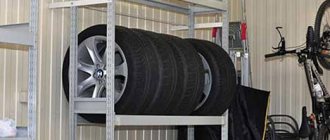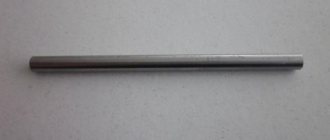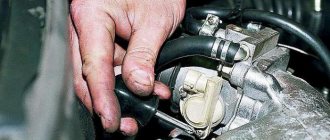As a rule, any car owner has at least two sets of tires - winter and summer. Accordingly, the question of storing an unused set of tires arises. Some car owners do not wonder how to properly store tires. As a result, the tires become unusable and you have to incur additional costs to purchase new tires. Moreover, you can ruin a summer set literally within a season. As a result, in the spring, instead of taking off winter tires and putting on summer tires, you will have to purchase a new set of tires. And all the problems are only due to improper storage of tires in your garage. By the way, you can store tires not only in the garage. There are special organizations that accept car tires for storage, providing proper conditions and care.
Rubber storage conditions
When asked how to store tires, you don’t have to ask friends or acquaintances for advice, or search on specialized forums and websites (although this is a useful and necessary thing). It is enough to study the legislation in the field of state standards. In particular, GOST R 54266-2010 provides the necessary information about the storage conditions for automobile rubber. It is called “Pneumatic tires. Packaging, transportation and storage." Despite the fact that the standard was developed in the Russian Federation, it complies with European standards and rules for storing tires. Let's briefly talk about the main conditions specified in the standard:
- it is allowed to store wheels in a garage or other premises with an operating temperature range from minus 30 to plus 30 degrees, and before use it is necessary to ensure that the tire is heated to a positive temperature;
- the minimum distance of the tire from the heating device is at least 1 meter;
- it is allowed to place car tires of any type on a flat surface (racks, floors or pallets); there are no sharp ribs or edges that can damage the rubber;
- if the tire width is less than 205 mm, then they can be stored in stacks no more than two meters high;
- tires with a width of 215 mm or more must stand vertically on the edge in several rows;
- large tires are stored at an (internal) pressure of 80-100 kPa, and they should not stand;
- proper storage of tires involves turning them over periodically, preferably once every three months, to change the fulcrum;
- tubeless tires must be stored in such a way as to prevent surface deformation;
- after use, rubber must be completely cleared of soil elements before storing it in a garage;
- if necessary, it is allowed to keep tires outdoors for a period of no more than a month, while the tires must be under a canopy or under reliable protection from environmental influences (sun, moisture).
Everyone understands that in a garage or country house, and even more so in an apartment, it is not always possible to achieve literal compliance with GOST requirements for storing tires. For example, if the tires are on the balcony, the requirement to leave the tires in the open air for a long period of time will not be met. On the other hand, tires are not afraid of frost down to minus 35 degrees, so you don’t have to worry about damaging your summer tire. The main thing is to protect the tire from precipitation and sunlight, because ultraviolet radiation is very harmful, it changes the structure of the rubber and reduces elasticity. As a conclusion, tires can be stored on the balcony, covered with waterproof material.
It is important to provide a clause to prevent tire deformation. In this case, it would be correct not to use tight places, not to press down the set of rubber with other objects, and to keep it on a flat surface. It is impossible to keep the tires standing all the time; they may undergo irreparable deformation and will only partially recover. Tires can remain in one position for no more than a month, after which they must be turned over.
Hanging storage of tires is prohibited. Although this type of rubber stay is found in some garages. On the other hand, the wheel assembly can hang quietly without much harm. Moreover, this method is the most successful for complete wheels; the only thing is that it is necessary to reduce the tire pressure.
Proper storage of tires involves keeping them away from heating devices, including radiators and heaters. This is a very important note that must be followed strictly. Otherwise, when exposed to high temperatures of more than 30 degrees, the rubber may suffer irreparable damage and become deformed.
Car owners often ask the question of how long different types of tires can be stored in a lying position. There is a GOST rule that regulates this option for storing rubber in a warehouse or garage. However, it does not always need to be followed strictly. It would be correct to have the tires in a lying position. It is also allowed that the tire will stand vertically, especially since many people store tires standing up in garages. Moreover, for the wheel assembly, standing in a standing position is also acceptable. The main thing is to control how much the kit already costs and change the position in a timely manner.
As for the service of storing winter or summer sets of tires, it is provided by many service stations that perform tire fitting, as well as large centers that sell car tires. Moreover, complete wheels and discs can also be stored. As a rule, such a service involves storing tires or wheels in a covered hangar without heating. The main thing is that the basic storage rule is observed - the temperature regime is maintained.
As for the general rules, car tires are not allowed to be near solvents and other chemical elements that can have a negative effect on the rubber. It is also unacceptable to be near ozone sources - transformers, electric motors and other equipment.
Where should you not keep rubber?
Keeping tires in improper conditions invariably leads to negative consequences - they quickly deteriorate and become unsuitable for use. Car owners take note - avoid seasonal storage in places such as:
- damp rooms without heating;
- staircases and public areas;
- an ordinary room in your apartment;
- under active sun;
- near heating devices;
- cold unglazed balconies.
Storing winter tires
After the end of winter, a period comes for all car owners when it is necessary to change their winter set of tires to summer ones. In this case, the problem is caused by the fact of replacement itself, but by the need for proper storage of tires throughout the entire summer period of operation.
The rules are simple:
- It is definitely worth marking winter tires in terms of their position on the car (front left, rear right, and so on), and after the summer when installing, swap them in order to evenly distribute wear;
- Before laying, the tires must be washed with water and dried thoroughly, remove dirt and stones from the tread;
- if you plan to store winter tires on rims, it is better to hang them or lay them horizontally;
- dismantled winter tires without rims should not be hung, it is better to place them vertically or stack them in a lying position;
- It is undesirable for tires to lie or stand in one position; the correct thing to do is to periodically change their position, rotate them by 20 degrees, and it is necessary to note how long they are in one state;
- It is necessary to ensure that winter tires are kept away from solvents and other chemicals, as well as gasoline, diesel fuel, and oil.
Features of storing various types of tires
Preservation rules vary depending on the type of tire:
- Before storage, winter tires must be thoroughly cleaned, washed from reagents and other chemicals used to treat roads. Summer tires can simply be washed and dirt and dust removed.
- If you do not plan to use the car in winter and change tires to “summer” ones, you can raise the vehicle using wooden beams or boards. This will relieve some of the pressure on the tires and extend their service life.
- When stored vertically, truck tires can be stacked in stacks up to one and a half meters high.
- When storing truck tires, they should be deflated to approximately 50% of the normal pressure. Experts recommend treating products with a special preservative aerosol.
Popular tire models
- Yandex.Market rating: Yandex.Market: 4.5
Goodyear Eagle F1 Asymmetric 3 SUV tiresSeasonality: summer Spikes: no Diameter: 17 / 18 / 19 / 20 / 21 / 22
- Yandex.Market rating: Yandex.Market: 4.5
Goodyear Eagle Sport TZ tires
Seasonality: summer Spikes: no Diameter: / 16 / 17 / 18
- Yandex.Market rating: Yandex.Market: 4.5
Goodyear EfficientGrip Performance Tires
Seasonality: summer Spikes: no Diameter: 15 / 16 / 17 / 18 / 19 / 20
- Goodyear UltraGrip Arctic 2 SUV Tires
Seasonality: winter Spikes: yes Diameter: 17 / 18 / 19 / 20 / 21
- Yandex.Market rating: Yandex.Market: 4.5
Goodyear UltraGrip Ice 2 tires
Seasonality: winter Spikes: no Diameter: 15 / 16 / 17 / 18 / 19
- Yandex.Market rating: Yandex.Market: 4
Goodyear Wrangler HP All Weather Tires
Seasonality: summer Spikes: no Diameter: 16 / 17 / 18 / 19
- Yandex.Market rating: Yandex.Market: 4.5
Goodyear Vector 4Seasons tires
Seasonality: all-season Spikes: no Diameter: 15 / 16 / 17 / 18
- Yandex.Market rating: Yandex.Market: 4
Goodyear EfficientGrip 2 SUV Tires
Seasonality: summer Spikes: no Diameter: 16 / 17 / 18 / 19 / 20
- Yandex.Market rating: Yandex.Market: 4.5
Goodyear UltraGrip Ice SUV Tires
Seasonality: winter Spikes: no Diameter: 16 / 17 / 18 / 19 / 20 / 21
- Yandex.Market rating: Yandex.Market: 4.5
Goodyear Wrangler All-Terrain Adventure tires with Kevlar
Seasonality: summer Spikes: no Diameter: 15 / 16 / 17 / 18 / 20
- Yandex.Market rating: Yandex.Market: 4.5
Goodyear EfficientGrip SUV Tires
Seasonality: summer Spikes: no Diameter: 16 / 17 / 18 / 19 / 20 / 21 / 22
- Yandex.Market rating: Yandex.Market: 4
Goodyear Eagle F1 Asymmetric SUV tires
Seasonality: summer Spikes: no Diameter: 17 / 18 / 19 / 20 / 22
- Goodyear UltraGrip Performance+ SUV Tires
Seasonality: winter Spikes: no Diameter: 16 / 17 / 18 / 19 / 20 / 21
- Yandex.Market rating: Yandex.Market: 5
Goodyear Vector 4Seasons Gen-3 SUV Tires
Seasonality: all-season Spikes: no Diameter: 16 / 17 / 18 / 19 / 20
What will result from improper storage?
When studying the question of how best to store summer and winter tires without rims, you should understand how important it is to maintain them correctly. As we wrote above, you must always remember the consequences that will lead to unnecessary costs and problems. For example, car tires may lose their original shape or dry out, which will certainly cause cracks and a decrease in strength. If the contents are inappropriate, there is a high probability of corrosion (on metal parts when stored as an assembly) and much more.
Storing summer tires
The procedure and rules for storing summer tires in winter are practically no different from the similar procedure for winter tires. First of all, the tires must be marked and thoroughly cleaned of any remaining dirt and small stones, and must also be rinsed and dried. Car tires wear out a lot in the summer, so it is worth swapping them when installing them after winter to ensure balance.
It is allowed to store car tires in a vertical or horizontal position in the summer. At the same time, if the tire is complete with a disk, then it should not stand. The wheel assembly will hang correctly on cables or ropes. Also, the correct position for a tire with a rim is lying horizontally. The wheels can be stacked in several pieces, no more than 4-5. If there is no other option for storing the wheels in the set other than standing, then you need to monitor how long they are in one position and periodically turn them to change the place of pressure. It would be correct to change the position once every 2-3 weeks.
Wheels without discs should not be hung correctly; they can become deformed from prolonged lateral load. Tires without rims can be stored in a stack, but no more than a month and in a stack no more than 5-6 pieces high. Although this is not the correct position for summer tires in a garage or hangar.
The most correct option is to place the tires vertically:
- on the floor;
- on racks;
- on pallets.
The main condition is a flat surface, without sharp edges and protrusions, so as not to damage the surface of the wheel. It is also correct to rotate the tires every 2-3 weeks.
In winter, temperatures can drop to very low levels. The main thing to remember is that you should not allow car tires to stay at temperatures below 35 degrees, in which case they may become deformed. It is best to store it in winter in a garage in compliance with the requirements specified above.
Where to store tires
You cannot store tires anywhere; their performance characteristics can be significantly deteriorated in one season. The most important thing is to eliminate the most unfavorable factors that destroy the rubber structure:
- high humidity;
- high air temperature;
- exposure to direct sunlight;
- dirt on the tires.
These factors cause premature aging of tires, a decrease in the elasticity of the rubber and the appearance of small cracks that are not visible to the eye.
Storing tires on the balcony
In principle, you can store tires on a glazed balcony, but the option, of course, is not the best. The tires will constantly lie on the balcony all year round (winter tires in summer, summer tires in winter), occupying the lion's share of the already small balcony space. If there are two cars in a family, then the tires will take up the entire balcony.
In winter, tires will be exposed to negative temperatures, and in summer they will be exposed to too high temperatures. This is not good for the tires.
Tires cannot be stored on an unglazed balcony, since they will be affected by all unfavorable factors at once: sudden temperature changes, significant negative temperatures, sun, rain, snow, condensation, dust.
If you have a large loggia with heating and ventilation, then very good storage conditions are created for tires. Ideally, cover them with a protective synthetic cover on top.
Storing tires in the garage
Tires can be stored in a garage, provided that the garage is non-metallic, heated and well ventilated. Tires should definitely be placed not on the floor, but on a stand or rack. In a metal garage, conditions for storing tires are not very good, since in winter they are exposed to low temperatures and condensation, and in summer the garage gets very hot from the sun.
Tire storage in the basement
Your own heated, ventilated basement is a very good place for seasonal tire storage. All that remains is to install them correctly, and your tires will remain in excellent condition until next season. Be sure to store tires on a pallet high above the floor, since in the spring the basement may suddenly flood with meltwater.
Storing tires in the country house or barn
Also not a very good option, since the tires will be subject to strong temperature changes and high humidity. It is especially convenient to store tires on your property if the tires are assembled with rims. In this case, there is no need to visit a tire shop twice a year and transfer tires to rims.
But you will have to change the set of wheels on the car yourself. To do this, you will need a rolling jack, a wheel wrench with an extension, and a compressor for inflating the tires. And you will be able to rearrange the wheels at any time convenient for you, and not wait in line for several hours at the tire shop when the urgent need to change the shoes of the car comes.
Specialized storage location
It is very convenient to store tires on your property; tires are always at hand, stored in the correct position and in compliance with the necessary conditions. But if this is not possible, then you can store tires in specialized places.
Seasonal tire storage services are provided by some tire centers, service centers, tire shops, and tire stores that are equipped with special warehouses. Typically, the cost of storing complete wheels or just tires is the same. Some tire centers provide tire storage services free of charge, subject to the purchase of seasonal tire service.
Companies providing such services must ensure that tires are stored correctly and that the necessary conditions are met. It’s good if you can go to the warehouse and see how the tires are stored, but most likely you won’t be able to do this and will have to take your word for it.
Most often, especially in large cities, tires are stored not in the city center, but in remote warehouses. In such cases, employees are asked to inform you 3-5 days in advance when you need tires so that they have time to bring them to you. This situation can be inconvenient if you need to urgently change at least two tires.
Temporary storage warehouse rental
In large cities there are temporary storage warehouses where you can rent a cell of the required volume for a certain period of time. This is especially convenient when there are several cars in the family. One set of tires occupies 1 m³, rental costs start from 1000 rubles per month. For two sets of tires you need to rent 2 m³. You get access to your cell and can put the tires in the correct position yourself.
Remember, if you store tires incorrectly, the structure of the rubber and its elastic properties are gradually damaged. This can lead to microcracks and cord delamination. Even if there is no visible damage to the tire, the car’s handling may deteriorate; a hernia may appear on the sidewalls, which may burst under load (for example, high speed). And this is a very unpleasant and dangerous moment.
Disk storage
If you have two sets of wheels, for example, winter and summer, then you will be interested in how the tires should be stored correctly in the garage or other place. In this case, it would be correct if the wheels did not lie down at all. In this case, they will not be subject to deformation under the influence of gravity.
The best storage for discs is hanging. To do this, the wheels must be thoroughly washed and free of dirt, and dried. It is correct to treat the rubber with a special care compound. The pressure in the wheels is reduced to 1-1.5 atmospheres.
It is advisable to mark the wheels so that you can understand where they were and change them after storage. In this case, you can correctly distribute the balance and prevent uneven abrasion of the rubber.
It is also possible to store wheels on rims in the garage horizontally, stacked on top of each other. How long you can store depends on the size of the wheel and its weight, but no more than 2 meters in height. Properly store on a flat surface, without corners or irregularities - on the garage floor or rack.
Rules for preparing tires for wintering
The main topic of the material is storing tires without rims, however, before sending tires to temporary rest, you need to prepare them for a break:
- Carefully inspect the tires without rims. If the tires are damaged, you should immediately contact a service center or replace your car tires.
- Wash the tires and rims thoroughly to ensure that no stones, oil or other contaminants remain on the tires.
- Dry your winter (or summer) tires. This will help avoid potential damage during the pause.
- Treat rubber without discs with protective agents to prevent deformation.
Now that the tires are fully prepared, you can safely store tires without rims at home. But before that, don't forget to read the rules.
Storage without disks
The rules for storing wheels without rims are no different from other options. It is correct to thoroughly prepare car tires for seasonal storage - this means cleaning them from dust and small debris, washing them, and drying them.
The main difference in storing wheels without rims is the proper way to keep them upright. In this case, they stand on a flat surface; the main thing is to periodically rotate them 20 degrees to prevent deformation of the rubber. The garage is an ideal place to store a seasonal set of wheels without rims. If, of course, the location allows and the basic requirements for temperature and humidity are met. They can stand on a special rack or floor, the main thing is that there are no irregularities or sharp corners, otherwise the surface of the tires can be easily damaged.
If the garage does not allow you to keep excess property in it, or there are not enough normal conditions for the car, then you can keep the tires on the balcony or in the storage room. The main thing is to maintain the temperature regime, store it correctly in direct sunlight (cover), and avoid being in conditions of high humidity or, conversely, excessively dry air.
You cannot hang tires without rims; you can allow them to lie in a stack or stand upright. At the same time, they should not lie for too long, correctly no more than a month, after all, this is not the main way of storing them.
Compliance with the above rules will allow you to use tires for a long time, without losing their useful properties and qualities.
How to properly store tires without rims in the garage
It is most convenient to keep them on specially equipped racks. To make them yourself, you will need to purchase the necessary building materials, and any truck owner will definitely have the right tools at hand.
In a cramped space, it will be problematic to arrange spacious shelving racks. In such a situation, the construction of a spacious hanging structure will be the most rational solution. The main thing is to secure it well to the wall to avoid the fastenings coming off due to the load.
When starting production, you need to first measure the tires and draw a schematic drawing, with the help of which it will be easier to understand the process, what and where to attach. When choosing metal materials, make sure you have a welding machine in advance. When using wood, remember that it needs to be processed (paint and varnish will be required at the final stage). Untreated boards will not last long.
The construction of the rack begins only after all the necessary measurements have been taken. You can decide what the future structure will be like by selecting suitable options on the Internet or coming up with a design yourself.
When estimating the parameters, do not forget that the wheels should not ultimately rest on the wall. The optimal distance between them is 1 cm. Also make sure to maintain a certain temperature in the room (about 25°C).
Video description
The video offers detailed instructions for installing a rack for storing car wheels:
Next, you need to make shelves, which can be made of wood or sheet materials. They should also be varnished to avoid the appearance of fungal diseases on their surface. Then straps are attached to prevent the wheels from rolling off from their storage locations. This completes the assembly of the wheel storage rack.
Such a device is quite inexpensive and can be purchased at a home improvement store or in a private workshop. Despite its simplicity, it is able to create optimal and very convenient conditions for storing tires and wheels.
Optimizing tires in the garage space - reliable, inexpensive, safe Source yandex.ru
Manufacturing technology for a simple wheel rack
The structure must be strong to withstand the weight placed on it. And also, if it is wood, then it should be coated with antiseptics to protect against fungus, and if it is metal, then it should be painted to prevent corrosion. Most often, manufacturers make wheel racks in the garage from profiles using welding. For shelves, chipboard, thick plywood or fiberboard are used.
First, in any case, a sketch of the future product is created. All further work is based on this project, because it contains the necessary dimensions and dimensions, and it also indicates fastening points and types of fittings.
The design of the rack for wheels can be made independently Source 999.md











